| Listing 1 - 10 of 10 |
Sort by
|
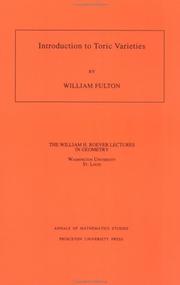
ISBN: 0691000492 0691033323 1400882524 Year: 1993 Publisher: Princeton, N.J. Princeton University Press
Abstract | Keywords | Export | Availability | Bookmark
 Loading...
Loading...Choose an application
- Reference Manager
- EndNote
- RefWorks (Direct export to RefWorks)
Toric varieties are algebraic varieties arising from elementary geometric and combinatorial objects such as convex polytopes in Euclidean space with vertices on lattice points. Since many algebraic geometry notions such as singularities, birational maps, cycles, homology, intersection theory, and Riemann-Roch translate into simple facts about polytopes, toric varieties provide a marvelous source of examples in algebraic geometry. In the other direction, general facts from algebraic geometry have implications for such polytopes, such as to the problem of the number of lattice points they contain. In spite of the fact that toric varieties are very special in the spectrum of all algebraic varieties, they provide a remarkably useful testing ground for general theories.The aim of this mini-course is to develop the foundations of the study of toric varieties, with examples, and describe some of these relations and applications. The text concludes with Stanley's theorem characterizing the numbers of simplicies in each dimension in a convex simplicial polytope. Although some general theorems are quoted without proof, the concrete interpretations via simplicial geometry should make the text accessible to beginners in algebraic geometry.
Algebraic geometry --- Differential geometry. Global analysis --- 512.7 --- Algebraic geometry. Commutative rings and algebras --- Toric varieties. --- 512.7 Algebraic geometry. Commutative rings and algebras --- Toric varieties --- Embeddings, Torus --- Torus embeddings --- Varieties, Toric --- Algebraic varieties --- Addition. --- Affine plane. --- Affine space. --- Affine variety. --- Alexander Grothendieck. --- Alexander duality. --- Algebraic curve. --- Algebraic group. --- Atiyah–Singer index theorem. --- Automorphism. --- Betti number. --- Big O notation. --- Characteristic class. --- Chern class. --- Chow group. --- Codimension. --- Cohomology. --- Combinatorics. --- Commutative property. --- Complete intersection. --- Convex polytope. --- Convex set. --- Coprime integers. --- Cotangent space. --- Dedekind sum. --- Dimension (vector space). --- Dimension. --- Direct proof. --- Discrete valuation ring. --- Discrete valuation. --- Disjoint union. --- Divisor (algebraic geometry). --- Divisor. --- Dual basis. --- Dual space. --- Equation. --- Equivalence class. --- Equivariant K-theory. --- Euler characteristic. --- Exact sequence. --- Explicit formula. --- Facet (geometry). --- Fundamental group. --- Graded ring. --- Grassmannian. --- H-vector. --- Hirzebruch surface. --- Hodge theory. --- Homogeneous coordinates. --- Homomorphism. --- Hypersurface. --- Intersection theory. --- Invertible matrix. --- Invertible sheaf. --- Isoperimetric inequality. --- Lattice (group). --- Leray spectral sequence. --- Limit point. --- Line bundle. --- Line segment. --- Linear subspace. --- Local ring. --- Mathematical induction. --- Mixed volume. --- Moduli space. --- Moment map. --- Monotonic function. --- Natural number. --- Newton polygon. --- Open set. --- Picard group. --- Pick's theorem. --- Polytope. --- Projective space. --- Quadric. --- Quotient space (topology). --- Regular sequence. --- Relative interior. --- Resolution of singularities. --- Restriction (mathematics). --- Resultant. --- Riemann–Roch theorem. --- Serre duality. --- Sign (mathematics). --- Simplex. --- Simplicial complex. --- Simultaneous equations. --- Spectral sequence. --- Subgroup. --- Subset. --- Summation. --- Surjective function. --- Tangent bundle. --- Theorem. --- Topology. --- Toric variety. --- Unit disk. --- Vector space. --- Weil conjecture. --- Zariski topology.
Book
ISBN: 069108176X 1322884951 1400869307 0691636443 Year: 1978 Publisher: Princeton, N.J.
Abstract | Keywords | Export | Availability | Bookmark
 Loading...
Loading...Choose an application
- Reference Manager
- EndNote
- RefWorks (Direct export to RefWorks)
The classical uniformization theorem for Riemann surfaces and its recent extensions can be viewed as introducing special pseudogroup structures, affine or projective structures, on Riemann surfaces. In fact, the additional structures involved can be considered as local forms of the uniformizations of Riemann surfaces. In this study, Robert Gunning discusses the corresponding pseudogroup structures on higher-dimensional complex manifolds, modeled on the theory as developed for Riemann surfaces.Originally published in 1978.The Princeton Legacy Library uses the latest print-on-demand technology to again make available previously out-of-print books from the distinguished backlist of Princeton University Press. These editions preserve the original texts of these important books while presenting them in durable paperback and hardcover editions. The goal of the Princeton Legacy Library is to vastly increase access to the rich scholarly heritage found in the thousands of books published by Princeton University Press since its founding in 1905.
Analytical spaces --- Differential geometry. Global analysis --- Complex manifolds --- Connections (Mathematics) --- Pseudogroups --- Mathematics --- Physical Sciences & Mathematics --- Calculus --- Global analysis (Mathematics) --- Lie groups --- Geometry, Differential --- Analytic spaces --- Manifolds (Mathematics) --- Adjunction formula. --- Affine connection. --- Affine transformation. --- Algebraic surface. --- Algebraic torus. --- Algebraic variety. --- Analytic continuation. --- Analytic function. --- Automorphic function. --- Automorphism. --- Bilinear form. --- Canonical bundle. --- Characterization (mathematics). --- Cohomology. --- Compact Riemann surface. --- Complex Lie group. --- Complex analysis. --- Complex dimension. --- Complex manifold. --- Complex multiplication. --- Complex number. --- Complex plane. --- Complex torus. --- Complex vector bundle. --- Contraction mapping. --- Covariant derivative. --- Differentiable function. --- Differentiable manifold. --- Differential equation. --- Differential form. --- Differential geometry. --- Differential operator. --- Dimension (vector space). --- Dimension. --- Elliptic operator. --- Elliptic surface. --- Enriques surface. --- Equation. --- Existential quantification. --- Explicit formula. --- Explicit formulae (L-function). --- Exterior derivative. --- Fiber bundle. --- General linear group. --- Geometric genus. --- Group homomorphism. --- Hausdorff space. --- Holomorphic function. --- Homomorphism. --- Identity matrix. --- Invariant subspace. --- Invertible matrix. --- Irreducible representation. --- Jacobian matrix and determinant. --- K3 surface. --- Kähler manifold. --- Lie algebra representation. --- Lie algebra. --- Line bundle. --- Linear equation. --- Linear map. --- Linear space (geometry). --- Linear subspace. --- Manifold. --- Mathematical analysis. --- Mathematical induction. --- Ordinary differential equation. --- Partial differential equation. --- Permutation. --- Polynomial. --- Principal bundle. --- Projection (linear algebra). --- Projective connection. --- Projective line. --- Pseudogroup. --- Quadratic transformation. --- Quotient space (topology). --- Representation theory. --- Riemann surface. --- Riemann–Roch theorem. --- Schwarzian derivative. --- Sheaf (mathematics). --- Special case. --- Subalgebra. --- Subgroup. --- Submanifold. --- Symmetric tensor. --- Symmetrization. --- Tangent bundle. --- Tangent space. --- Tensor field. --- Tensor product. --- Tensor. --- Theorem. --- Topological manifold. --- Uniformization theorem. --- Uniformization. --- Unit (ring theory). --- Vector bundle. --- Vector space. --- Fonctions de plusieurs variables complexes --- Variétés complexes
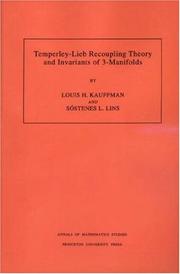
ISBN: 0691036411 0691036403 1400882532 9780691036403 9780691036410 Year: 1994 Volume: 134 Publisher: Princeton, N.J. Princeton University Press
Abstract | Keywords | Export | Availability | Bookmark
 Loading...
Loading...Choose an application
- Reference Manager
- EndNote
- RefWorks (Direct export to RefWorks)
This book offers a self-contained account of the 3-manifold invariants arising from the original Jones polynomial. These are the Witten-Reshetikhin-Turaev and the Turaev-Viro invariants. Starting from the Kauffman bracket model for the Jones polynomial and the diagrammatic Temperley-Lieb algebra, higher-order polynomial invariants of links are constructed and combined to form the 3-manifold invariants. The methods in this book are based on a recoupling theory for the Temperley-Lieb algebra. This recoupling theory is a q-deformation of the SU(2) spin networks of Roger Penrose. The recoupling theory is developed in a purely combinatorial and elementary manner. Calculations are based on a reformulation of the Kirillov-Reshetikhin shadow world, leading to expressions for all the invariants in terms of state summations on 2-cell complexes. Extensive tables of the invariants are included. Manifolds in these tables are recognized by surgery presentations and by means of 3-gems (graph encoded 3-manifolds) in an approach pioneered by Sostenes Lins. The appendices include information about gems, examples of distinct manifolds with the same invariants, and applications to the Turaev-Viro invariant and to the Crane-Yetter invariant of 4-manifolds.
Drie-menigvuldigheden (Topologie) --- Knopentheorie --- Knot theory --- Noeuds [Theorie des ] --- Three-manifolds (Topology) --- Trois-variétés (Topologie) --- Knot theory. --- Algebraic topology --- Invariants --- Mathematics --- Invariants (Mathematics) --- Invariants. --- 3-manifolds (Topology) --- Manifolds, Three dimensional (Topology) --- Three-dimensional manifolds (Topology) --- Low-dimensional topology --- Topological manifolds --- Knots (Topology) --- 3-manifold. --- Addition. --- Algorithm. --- Ambient isotopy. --- Axiom. --- Backslash. --- Barycentric subdivision. --- Bijection. --- Bipartite graph. --- Borromean rings. --- Boundary parallel. --- Bracket polynomial. --- Calculation. --- Canonical form. --- Cartesian product. --- Cobordism. --- Coefficient. --- Combination. --- Commutator. --- Complex conjugate. --- Computation. --- Connected component (graph theory). --- Connected sum. --- Cubic graph. --- Diagram (category theory). --- Dimension. --- Disjoint sets. --- Disjoint union. --- Elaboration. --- Embedding. --- Equation. --- Equivalence class. --- Explicit formula. --- Explicit formulae (L-function). --- Factorial. --- Fundamental group. --- Graph (discrete mathematics). --- Graph embedding. --- Handlebody. --- Homeomorphism. --- Homology (mathematics). --- Identity element. --- Intersection form (4-manifold). --- Inverse function. --- Jones polynomial. --- Kirby calculus. --- Line segment. --- Linear independence. --- Matching (graph theory). --- Mathematical physics. --- Mathematical proof. --- Mathematics. --- Maxima and minima. --- Monograph. --- Natural number. --- Network theory. --- Notation. --- Numerical analysis. --- Orientability. --- Orthogonality. --- Pairing. --- Pairwise. --- Parametrization. --- Parity (mathematics). --- Partition function (mathematics). --- Permutation. --- Poincaré conjecture. --- Polyhedron. --- Quantum group. --- Quantum invariant. --- Recoupling. --- Recursion. --- Reidemeister move. --- Result. --- Roger Penrose. --- Root of unity. --- Scientific notation. --- Sequence. --- Significant figures. --- Simultaneous equations. --- Smoothing. --- Special case. --- Sphere. --- Spin network. --- Summation. --- Symmetric group. --- Tetrahedron. --- The Geometry Center. --- Theorem. --- Theory. --- Three-dimensional space (mathematics). --- Time complexity. --- Tubular neighborhood. --- Two-dimensional space. --- Vector field. --- Vector space. --- Vertex (graph theory). --- Winding number. --- Writhe.
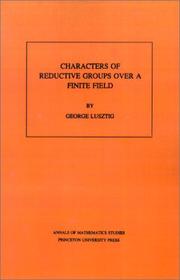
ISBN: 0691083509 0691083517 1400881773 9780691083513 9780691083506 Year: 1984 Volume: 107 Publisher: Princeton, N.J.
Abstract | Keywords | Export | Availability | Bookmark
 Loading...
Loading...Choose an application
- Reference Manager
- EndNote
- RefWorks (Direct export to RefWorks)
This book presents a classification of all (complex)irreducible representations of a reductive group withconnected centre, over a finite field. To achieve this,the author uses etale intersection cohomology, anddetailed information on representations of Weylgroups.
512 --- Characters of groups --- Finite fields (Algebra) --- Finite groups --- Groups, Finite --- Group theory --- Modules (Algebra) --- Modular fields (Algebra) --- Algebra, Abstract --- Algebraic fields --- Galois theory --- Characters, Group --- Group characters --- Groups, Characters of --- Representations of groups --- Rings (Algebra) --- Algebra --- 512 Algebra --- Finite groups. --- Characters of groups. --- Addition. --- Algebra representation. --- Algebraic closure. --- Algebraic group. --- Algebraic variety. --- Algebraically closed field. --- Bijection. --- Borel subgroup. --- Cartan subalgebra. --- Character table. --- Character theory. --- Characteristic function (probability theory). --- Characteristic polynomial. --- Class function (algebra). --- Classical group. --- Coefficient. --- Cohomology with compact support. --- Cohomology. --- Combination. --- Complex number. --- Computation. --- Conjugacy class. --- Connected component (graph theory). --- Coxeter group. --- Cyclic group. --- Cyclotomic polynomial. --- David Kazhdan. --- Dense set. --- Derived category. --- Diagram (category theory). --- Dimension. --- Direct sum. --- Disjoint sets. --- Disjoint union. --- E6 (mathematics). --- Eigenvalues and eigenvectors. --- Endomorphism. --- Equivalence class. --- Equivalence relation. --- Existential quantification. --- Explicit formula. --- Explicit formulae (L-function). --- Fiber bundle. --- Finite field. --- Finite group. --- Fourier transform. --- Green's function. --- Group (mathematics). --- Group action. --- Group representation. --- Harish-Chandra. --- Hecke algebra. --- Identity element. --- Integer. --- Irreducible representation. --- Isomorphism class. --- Jordan decomposition. --- Line bundle. --- Linear combination. --- Local system. --- Mathematical induction. --- Maximal torus. --- Module (mathematics). --- Monodromy. --- Morphism. --- Orthonormal basis. --- P-adic number. --- Parametrization. --- Parity (mathematics). --- Partially ordered set. --- Perverse sheaf. --- Pointwise. --- Polynomial. --- Quantity. --- Rational point. --- Reductive group. --- Ree group. --- Schubert variety. --- Scientific notation. --- Semisimple Lie algebra. --- Sheaf (mathematics). --- Simple group. --- Simple module. --- Special case. --- Standard basis. --- Subset. --- Subtraction. --- Summation. --- Surjective function. --- Symmetric group. --- Tensor product. --- Theorem. --- Two-dimensional space. --- Unipotent representation. --- Vector bundle. --- Vector space. --- Verma module. --- Weil conjecture. --- Weyl group. --- Zariski topology.
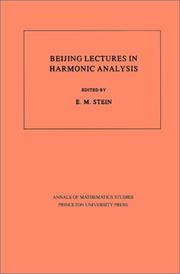
ISBN: 0691084181 069108419X 1400882095 Year: 2016 Publisher: Princeton, NJ : Princeton University Press,
Abstract | Keywords | Export | Availability | Bookmark
 Loading...
Loading...Choose an application
- Reference Manager
- EndNote
- RefWorks (Direct export to RefWorks)
Based on seven lecture series given by leading experts at a summer school at Peking University, in Beijing, in 1984. this book surveys recent developments in the areas of harmonic analysis most closely related to the theory of singular integrals, real-variable methods, and applications to several complex variables and partial differential equations. The different lecture series are closely interrelated; each contains a substantial amount of background material, as well as new results not previously published. The contributors to the volume are R. R. Coifman and Yves Meyer, Robert Fcfferman,Carlos K. Kenig, Steven G. Krantz, Alexander Nagel, E. M. Stein, and Stephen Wainger.
Harmonic analysis. --- Analysis (Mathematics) --- Functions, Potential --- Potential functions --- Banach algebras --- Calculus --- Mathematical analysis --- Mathematics --- Bessel functions --- Fourier series --- Harmonic functions --- Time-series analysis --- Analytic function. --- Asymptotic formula. --- Bergman metric. --- Bernhard Riemann. --- Bessel function. --- Biholomorphism. --- Boundary value problem. --- Bounded mean oscillation. --- Bounded operator. --- Boundedness. --- Cauchy's integral formula. --- Characteristic function (probability theory). --- Characterization (mathematics). --- Coefficient. --- Commutator. --- Complexification (Lie group). --- Continuous function. --- Convolution. --- Degeneracy (mathematics). --- Differential equation. --- Differential operator. --- Dirac delta function. --- Dirichlet problem. --- Equation. --- Estimation. --- Existence theorem. --- Existential quantification. --- Explicit formula. --- Explicit formulae (L-function). --- Fatou's theorem. --- Fourier analysis. --- Fourier integral operator. --- Fourier transform. --- Fredholm theory. --- Fubini's theorem. --- Function (mathematics). --- Functional calculus. --- Fundamental solution. --- Gaussian curvature. --- Hardy space. --- Harmonic function. --- Harmonic measure. --- Heisenberg group. --- Hilbert space. --- Hilbert transform. --- Hodge theory. --- Holomorphic function. --- Hyperbolic partial differential equation. --- Hölder's inequality. --- Infimum and supremum. --- Integration by parts. --- Interpolation theorem. --- Intersection (set theory). --- Invertible matrix. --- Isometry group. --- Laplace operator. --- Laplace's equation. --- Lebesgue measure. --- Linear map. --- Lipschitz continuity. --- Lipschitz domain. --- Lp space. --- Mathematical induction. --- Mathematical physics. --- Maximal function. --- Maximum principle. --- Measure (mathematics). --- Newtonian potential. --- Non-Euclidean geometry. --- Number theory. --- Operator theory. --- Oscillatory integral. --- Parameter. --- Partial derivative. --- Partial differential equation. --- Polynomial. --- Power series. --- Product metric. --- Radon–Nikodym theorem. --- Riemannian manifold. --- Riesz representation theorem. --- Scientific notation. --- Several complex variables. --- Sign (mathematics). --- Simultaneous equations. --- Singular function. --- Singular integral. --- Sobolev space. --- Square (algebra). --- Statistical hypothesis testing. --- Stokes' theorem. --- Support (mathematics). --- Tangent space. --- Tensor product. --- Theorem. --- Trigonometric series. --- Uniformization theorem. --- Variable (mathematics). --- Vector field.
Book
ISBN: 0691082189 1322886407 0691628084 0691648328 1400867312 Year: 1978 Publisher: Princeton, N.J.
Abstract | Keywords | Export | Availability | Bookmark
 Loading...
Loading...Choose an application
- Reference Manager
- EndNote
- RefWorks (Direct export to RefWorks)
Written by Arthur Ogus on the basis of notes from Pierre Berthelot's seminar on crystalline cohomology at Princeton University in the spring of 1974, this book constitutes an informal introduction to a significant branch of algebraic geometry. Specifically, it provides the basic tools used in the study of crystalline cohomology of algebraic varieties in positive characteristic.Originally published in 1978.The Princeton Legacy Library uses the latest print-on-demand technology to again make available previously out-of-print books from the distinguished backlist of Princeton University Press. These editions preserve the original texts of these important books while presenting them in durable paperback and hardcover editions. The goal of the Princeton Legacy Library is to vastly increase access to the rich scholarly heritage found in the thousands of books published by Princeton University Press since its founding in 1905.
Algebraic geometry --- Geometry, Algebraic. --- Homology theory. --- Functions, Zeta. --- Zeta functions --- Cohomology theory --- Contrahomology theory --- Algebraic topology --- Geometry --- Abelian category. --- Additive map. --- Adjoint functors. --- Adjunction (field theory). --- Adjunction formula. --- Alexander Grothendieck. --- Algebra homomorphism. --- Artinian. --- Automorphism. --- Axiom. --- Banach space. --- Base change map. --- Base change. --- Betti number. --- Calculation. --- Cartesian product. --- Category of abelian groups. --- Characteristic polynomial. --- Characterization (mathematics). --- Closed immersion. --- Codimension. --- Coefficient. --- Cohomology. --- Cokernel. --- Commutative diagram. --- Commutative property. --- Commutative ring. --- Compact space. --- Corollary. --- Crystalline cohomology. --- De Rham cohomology. --- Degeneracy (mathematics). --- Derived category. --- Diagram (category theory). --- Differential operator. --- Discrete valuation ring. --- Divisibility rule. --- Dual basis. --- Eigenvalues and eigenvectors. --- Endomorphism. --- Epimorphism. --- Equation. --- Equivalence of categories. --- Exact sequence. --- Existential quantification. --- Explicit formula. --- Explicit formulae (L-function). --- Exponential type. --- Exterior algebra. --- Exterior derivative. --- Formal power series. --- Formal scheme. --- Frobenius endomorphism. --- Functor. --- Fundamental theorem. --- Hasse invariant. --- Hodge theory. --- Homotopy. --- Ideal (ring theory). --- Initial and terminal objects. --- Inverse image functor. --- Inverse limit. --- Inverse system. --- K-theory. --- Leray spectral sequence. --- Linear map. --- Linearization. --- Locally constant function. --- Mapping cone (homological algebra). --- Mathematical induction. --- Maximal ideal. --- Module (mathematics). --- Monomial. --- Monotonic function. --- Morphism. --- Natural transformation. --- Newton polygon. --- Noetherian ring. --- Noetherian. --- P-adic number. --- Polynomial. --- Power series. --- Presheaf (category theory). --- Projective module. --- Scientific notation. --- Series (mathematics). --- Sheaf (mathematics). --- Sheaf of modules. --- Special case. --- Spectral sequence. --- Subring. --- Subset. --- Symmetric algebra. --- Theorem. --- Topological space. --- Topology. --- Topos. --- Transitive relation. --- Universal property. --- Zariski topology. --- Geometrie algebrique --- Topologie algebrique --- Varietes algebriques --- Cohomologie
Book
ISBN: 128245837X 9786612458378 1400829062 0691137323 0691137315 9781400829064 9780691137315 9780691137322 6612458372 Year: 2008 Publisher: Princeton, NJ
Abstract | Keywords | Export | Availability | Bookmark
 Loading...
Loading...Choose an application
- Reference Manager
- EndNote
- RefWorks (Direct export to RefWorks)
This book presents the analytic foundations to the theory of the hypoelliptic Laplacian. The hypoelliptic Laplacian, a second-order operator acting on the cotangent bundle of a compact manifold, is supposed to interpolate between the classical Laplacian and the geodesic flow. Jean-Michel Bismut and Gilles Lebeau establish the basic functional analytic properties of this operator, which is also studied from the perspective of local index theory and analytic torsion. The book shows that the hypoelliptic Laplacian provides a geometric version of the Fokker-Planck equations. The authors give the proper functional analytic setting in order to study this operator and develop a pseudodifferential calculus, which provides estimates on the hypoelliptic Laplacian's resolvent. When the deformation parameter tends to zero, the hypoelliptic Laplacian converges to the standard Hodge Laplacian of the base by a collapsing argument in which the fibers of the cotangent bundle collapse to a point. For the local index theory, small time asymptotics for the supertrace of the associated heat kernel are obtained. The Ray-Singer analytic torsion of the hypoelliptic Laplacian as well as the associated Ray-Singer metrics on the determinant of the cohomology are studied in an equivariant setting, resulting in a key comparison formula between the elliptic and hypoelliptic analytic torsions.
Differential equations, Hypoelliptic. --- Laplacian operator. --- Metric spaces. --- Spaces, Metric --- Operator, Laplacian --- Hypoelliptic differential equations --- Generalized spaces --- Set theory --- Topology --- Differential equations, Partial --- Alexander Grothendieck. --- Analytic function. --- Asymptote. --- Asymptotic expansion. --- Berezin integral. --- Bijection. --- Brownian dynamics. --- Brownian motion. --- Chaos theory. --- Chern class. --- Classical Wiener space. --- Clifford algebra. --- Cohomology. --- Combination. --- Commutator. --- Computation. --- Connection form. --- Coordinate system. --- Cotangent bundle. --- Covariance matrix. --- Curvature tensor. --- Curvature. --- De Rham cohomology. --- Derivative. --- Determinant. --- Differentiable manifold. --- Differential operator. --- Dirac operator. --- Direct proof. --- Eigenform. --- Eigenvalues and eigenvectors. --- Ellipse. --- Embedding. --- Equation. --- Estimation. --- Euclidean space. --- Explicit formula. --- Explicit formulae (L-function). --- Feynman–Kac formula. --- Fiber bundle. --- Fokker–Planck equation. --- Formal power series. --- Fourier series. --- Fourier transform. --- Fredholm determinant. --- Function space. --- Girsanov theorem. --- Ground state. --- Heat kernel. --- Hilbert space. --- Hodge theory. --- Holomorphic function. --- Holomorphic vector bundle. --- Hypoelliptic operator. --- Integration by parts. --- Invertible matrix. --- Logarithm. --- Malliavin calculus. --- Martingale (probability theory). --- Matrix calculus. --- Mellin transform. --- Morse theory. --- Notation. --- Parameter. --- Parametrix. --- Parity (mathematics). --- Polynomial. --- Principal bundle. --- Probabilistic method. --- Projection (linear algebra). --- Rectangle. --- Resolvent set. --- Ricci curvature. --- Riemann–Roch theorem. --- Scientific notation. --- Self-adjoint operator. --- Self-adjoint. --- Sign convention. --- Smoothness. --- Sobolev space. --- Spectral theory. --- Square root. --- Stochastic calculus. --- Stochastic process. --- Summation. --- Supertrace. --- Symmetric space. --- Tangent space. --- Taylor series. --- Theorem. --- Theory. --- Torus. --- Trace class. --- Translational symmetry. --- Transversality (mathematics). --- Uniform convergence. --- Variable (mathematics). --- Vector bundle. --- Vector space. --- Wave equation.
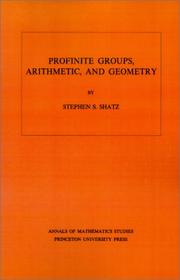
ISBN: 0691080178 1400881854 9780691080178 Year: 1972 Volume: 67 Publisher: Princeton (N.J.): Princeton university press
Abstract | Keywords | Export | Availability | Bookmark
 Loading...
Loading...Choose an application
- Reference Manager
- EndNote
- RefWorks (Direct export to RefWorks)
In this volume, the author covers profinite groups and their cohomology, Galois cohomology, and local class field theory, and concludes with a treatment of duality. His objective is to present effectively that body of material upon which all modern research in Diophantine geometry and higher arithmetic is based, and to do so in a manner that emphasizes the many interesting lines of inquiry leading from these foundations.
Group theory --- Finite groups --- Algebraic number theory --- 512.73 --- 512.66 --- Homology theory --- Number theory --- Cohomology theory --- Contrahomology theory --- Algebraic topology --- Groups, Finite --- Modules (Algebra) --- Cohomology theory of algebraic varieties and schemes --- Homological algebra --- 512.66 Homological algebra --- 512.73 Cohomology theory of algebraic varieties and schemes --- Groupes, Théorie des. --- Group theory. --- Homology theory. --- Finite groups. --- Algebraic number theory. --- Abelian group. --- Alexander Grothendieck. --- Algebraic closure. --- Algebraic extension. --- Algebraic geometry. --- Algebraic number field. --- Brauer group. --- Category of abelian groups. --- Category of sets. --- Characterization (mathematics). --- Class field theory. --- Cohomological dimension. --- Cohomology. --- Cokernel. --- Commutative diagram. --- Composition series. --- Computation. --- Connected component (graph theory). --- Coset. --- Cup product. --- Dedekind domain. --- Degeneracy (mathematics). --- Diagram (category theory). --- Dimension (vector space). --- Diophantine geometry. --- Discrete group. --- Equivalence of categories. --- Exact sequence. --- Existential quantification. --- Explicit formula. --- Exponential function. --- Family of sets. --- Field extension. --- Finite group. --- Fundamental class. --- G-module. --- Galois cohomology. --- Galois extension. --- Galois group. --- Galois module. --- Galois theory. --- General topology. --- Geometry. --- Grothendieck topology. --- Group cohomology. --- Group extension. --- Group scheme. --- Hilbert symbol. --- Hopf algebra. --- Ideal (ring theory). --- Inequality (mathematics). --- Injective sheaf. --- Inner automorphism. --- Inverse limit. --- Kummer theory. --- Lie algebra. --- Linear independence. --- Local field. --- Mathematical induction. --- Mathematician. --- Mathematics. --- Module (mathematics). --- Morphism. --- Natural topology. --- Neighbourhood (mathematics). --- Normal extension. --- Normal subgroup. --- Number theory. --- P-adic number. --- P-group. --- Polynomial. --- Pontryagin duality. --- Power series. --- Prime number. --- Principal ideal. --- Profinite group. --- Quadratic reciprocity. --- Quotient group. --- Ring of integers. --- Sheaf (mathematics). --- Special case. --- Subcategory. --- Subgroup. --- Supernatural number. --- Sylow theorems. --- Tangent space. --- Theorem. --- Topological group. --- Topological property. --- Topological ring. --- Topological space. --- Topology. --- Torsion group. --- Torsion subgroup. --- Transcendence degree. --- Triviality (mathematics). --- Unique factorization domain. --- Variable (mathematics). --- Vector space. --- Groupes, Théorie des --- Nombres, Théorie des

ISBN: 0691081794 0691081840 1400881560 9780691081793 Year: 1976 Volume: no. 87 Publisher: Princeton, N.J.
Abstract | Keywords | Export | Availability | Bookmark
 Loading...
Loading...Choose an application
- Reference Manager
- EndNote
- RefWorks (Direct export to RefWorks)
The application by Fadeev and Pavlov of the Lax-Phillips scattering theory to the automorphic wave equation led Professors Lax and Phillips to reexamine this development within the framework of their theory. This volume sets forth the results of that work in the form of new or more straightforward treatments of the spectral theory of the Laplace-Beltrami operator over fundamental domains of finite area; the meromorphic character over the whole complex plane of the Eisenstein series; and the Selberg trace formula.CONTENTS: 1. Introduction. 2. An abstract scattering theory. 3. A modified theory for second order equations with an indefinite energy form. 4. The Laplace-Beltrami operator for the modular group. 5. The automorphic wave equation. 6. Incoming and outgoing subspaces for the automorphic wave equations. 7. The scattering matrix for the automorphic wave equation. 8. The general case. 9. The Selberg trace formula.
Harmonic analysis. Fourier analysis --- Automorphic functions --- Scattering (Mathematics) --- Fonctions automorphes --- Dispersion (Mathématiques) --- Automorphic functions. --- Scattering (Mathematics). --- Dispersion (Mathématiques) --- Selberg, Formule de trace de --- Selberg trace formula --- Eisenstein series --- Eisenstein, Séries d' --- Scattering theory (Mathematics) --- Boundary value problems --- Differential equations, Partial --- Scattering operator --- Fuchsian functions --- Functions, Automorphic --- Functions, Fuchsian --- Functions of several complex variables --- Absolute continuity. --- Algebra. --- Analytic continuation. --- Analytic function. --- Annulus (mathematics). --- Asymptotic distribution. --- Automorphic function. --- Bilinear form. --- Boundary (topology). --- Boundary value problem. --- Bounded operator. --- Calculation. --- Cauchy sequence. --- Change of variables. --- Complex plane. --- Conjugacy class. --- Convolution. --- Cusp neighborhood. --- Cyclic group. --- Derivative. --- Differential equation. --- Differential operator. --- Dimension (vector space). --- Dimensional analysis. --- Dirichlet integral. --- Dirichlet series. --- Eigenfunction. --- Eigenvalues and eigenvectors. --- Eisenstein series. --- Elliptic operator. --- Elliptic partial differential equation. --- Equation. --- Equivalence class. --- Even and odd functions. --- Existential quantification. --- Explicit formula. --- Explicit formulae (L-function). --- Exponential function. --- Fourier transform. --- Function space. --- Functional analysis. --- Functional calculus. --- Fundamental domain. --- Harmonic analysis. --- Hilbert space. --- Hyperbolic partial differential equation. --- Infinitesimal generator (stochastic processes). --- Integral equation. --- Integration by parts. --- Invariant subspace. --- Laplace operator. --- Laplace transform. --- Lebesgue measure. --- Linear differential equation. --- Linear space (geometry). --- Matrix (mathematics). --- Maximum principle. --- Meromorphic function. --- Modular group. --- Neumann boundary condition. --- Norm (mathematics). --- Null vector. --- Number theory. --- Operator theory. --- Orthogonal complement. --- Orthonormal basis. --- Paley–Wiener theorem. --- Partial differential equation. --- Perturbation theory (quantum mechanics). --- Perturbation theory. --- Primitive element (finite field). --- Principal component analysis. --- Projection (linear algebra). --- Quadratic form. --- Removable singularity. --- Representation theorem. --- Resolvent set. --- Riemann hypothesis. --- Riemann surface. --- Riemann zeta function. --- Riesz representation theorem. --- Scatter matrix. --- Scattering theory. --- Schwarz reflection principle. --- Selberg trace formula. --- Self-adjoint. --- Semigroup. --- Sign (mathematics). --- Spectral theory. --- Subgroup. --- Subsequence. --- Summation. --- Support (mathematics). --- Theorem. --- Trace class. --- Trace formula. --- Unitary operator. --- Wave equation. --- Weighted arithmetic mean. --- Winding number. --- Eisenstein, Séries d'. --- Analyse harmonique
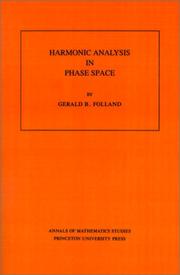
ISBN: 0691085277 0691085285 1400882427 9780691085289 9780691085272 Year: 1989 Volume: 122 Publisher: Princeton (N.J.): Princeton university press
Abstract | Keywords | Export | Availability | Bookmark
 Loading...
Loading...Choose an application
- Reference Manager
- EndNote
- RefWorks (Direct export to RefWorks)
This book provides the first coherent account of the area of analysis that involves the Heisenberg group, quantization, the Weyl calculus, the metaplectic representation, wave packets, and related concepts. This circle of ideas comes principally from mathematical physics, partial differential equations, and Fourier analysis, and it illuminates all these subjects. The principal features of the book are as follows: a thorough treatment of the representations of the Heisenberg group, their associated integral transforms, and the metaplectic representation; an exposition of the Weyl calculus of pseudodifferential operators, with emphasis on ideas coming from harmonic analysis and physics; a discussion of wave packet transforms and their applications; and a new development of Howe's theory of the oscillator semigroup.
Harmonic analysis. Fourier analysis --- Phase space (Statistical physics) --- Harmonic analysis --- 512.54 <043> --- 530.145 <043> --- 517.986.6 --- 51-7 <043> --- 517.986.6 <043> --- Groups. Group theory--Dissertaties --- Quantum theory--Dissertaties --- Harmonic analysis of functions of groups and homogeneous spaces --- Mathematical studies and methods in other sciences. Scientific mathematics. Actuarial mathematics. Biometrics. Econometrics etc.--Dissertaties --- Harmonic analysis of functions of groups and homogeneous spaces--Dissertaties --- 517.986.6 <043> Harmonic analysis of functions of groups and homogeneous spaces--Dissertaties --- 51-7 <043> Mathematical studies and methods in other sciences. Scientific mathematics. Actuarial mathematics. Biometrics. Econometrics etc.--Dissertaties --- 517.986.6 Harmonic analysis of functions of groups and homogeneous spaces --- 530.145 <043> Quantum theory--Dissertaties --- 512.54 <043> Groups. Group theory--Dissertaties --- Space, Phase (Statistical physics) --- Generalized spaces --- Analysis (Mathematics) --- Functions, Potential --- Potential functions --- Banach algebras --- Calculus --- Mathematical analysis --- Mathematics --- Bessel functions --- Fourier series --- Harmonic functions --- Time-series analysis --- Harmonic analysis. --- Analytic continuation. --- Analytic function. --- Antisymmetric tensor. --- Asymptotic expansion. --- Automorphism. --- Bilinear form. --- Bounded operator. --- Calculation. --- Canonical commutation relation. --- Canonical transformation. --- Cauchy–Riemann equations. --- Cayley transform. --- Class function (algebra). --- Classical mechanics. --- Commutative property. --- Complex analysis. --- Configuration space. --- Differential equation. --- Differential geometry. --- Differential operator. --- Eigenvalues and eigenvectors. --- Equation. --- Explicit formula. --- Fock space. --- Fourier analysis. --- Fourier integral operator. --- Fourier transform. --- Functional analysis. --- Gaussian function. --- Gaussian integral. --- Geometric quantization. --- Hamiltonian mechanics. --- Hamiltonian vector field. --- Heisenberg group. --- Hermite polynomials. --- Hermitian symmetric space. --- Hilbert space. --- Hilbert transform. --- Integral transform. --- Invariant subspace. --- Irreducible representation. --- Lebesgue measure. --- Lie algebra. --- Lie superalgebra. --- Lie theory. --- Mathematical physics. --- Number theory. --- Observable. --- Ordinary differential equation. --- Orthonormal basis. --- Oscillator representation. --- Oscillatory integral. --- Partial differential equation. --- Phase factor. --- Phase space. --- Point at infinity. --- Poisson bracket. --- Polynomial. --- Power series. --- Probability. --- Projection (linear algebra). --- Projective Hilbert space. --- Projective representation. --- Projective space. --- Pseudo-differential operator. --- Pullback (category theory). --- Quadratic function. --- Quantum harmonic oscillator. --- Quantum mechanics. --- Representation theory. --- Schrödinger equation. --- Self-adjoint operator. --- Semigroup. --- Several complex variables. --- Siegel disc. --- Sobolev space. --- Spectral theorem. --- Spectral theory. --- State-space representation. --- Stone's theorem. --- Stone–Weierstrass theorem. --- Summation. --- Symmetric space. --- Symmetric tensor. --- Symplectic geometry. --- Symplectic group. --- Symplectic vector space. --- Symplectomorphism. --- Tangent space. --- Tangent vector. --- Theorem. --- Translational symmetry. --- Unbounded operator. --- Unit vector. --- Unitarity (physics). --- Unitary operator. --- Unitary representation. --- Variable (mathematics). --- Wave packet.
| Listing 1 - 10 of 10 |
Sort by
|

 Search
Search Feedback
Feedback About UniCat
About UniCat  Help
Help News
News